Get to know Armenian Easter Bread, or Choereg, a beautiful and delicious braided bread traditionally perfumed with mahleb and anise. Intrigued? Read on!
Looking for more Easter bread from around the world? I’ve got you covered.
For ease of browsing, here are all of my yeasted sweet breads.
Note that I made this bread for my friend’s communion service. If you are interested in more of my communion breads, see my milk and honey loaf and my champagne yeast pita. Yes, we schemed up a lot of interesting breads for her congregation!
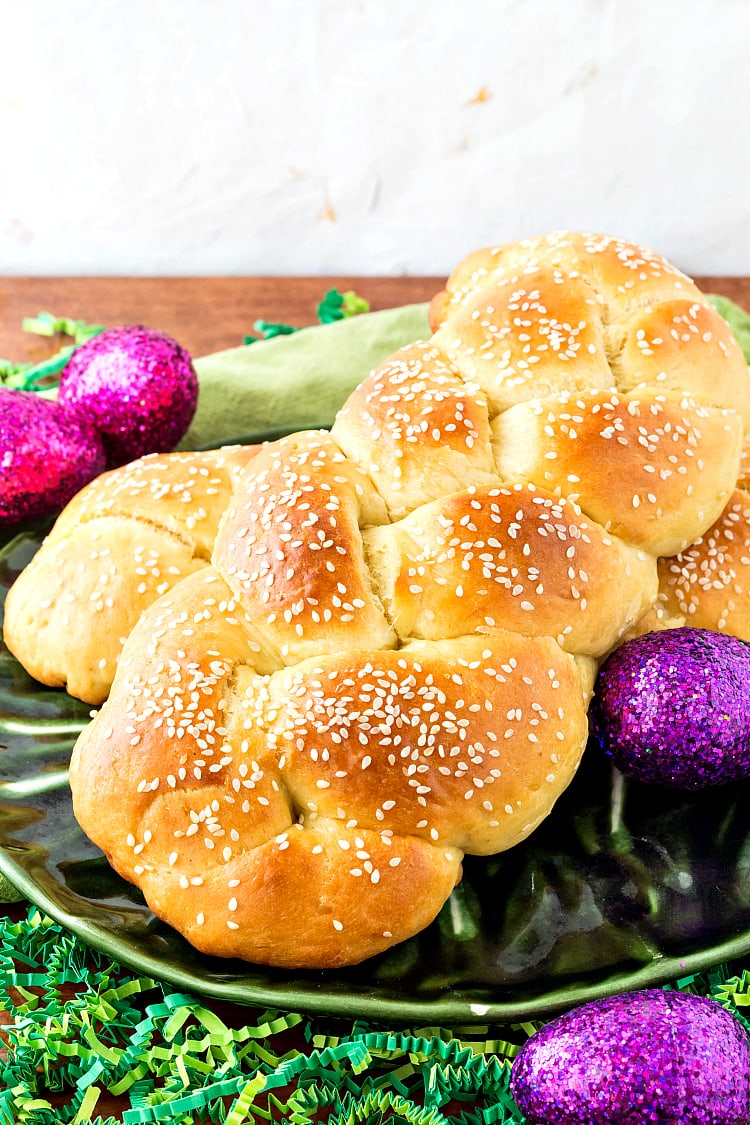
Enriched Dough for Celebration Breads
Like many other celebration breads, this Armenian sweet bread is made from an enriched dough. (Note that it is very similar to the Greek Tsoureki.)
When I say “enriched dough,” I just mean that along with the standard flour, salt, yeast, and water that make up a basic bread, the dough is enriched with eggs, sugar, and fat to bake up into a softer, richer bread.
For other examples of enriched dough, look at these recipes:
Pastry Chef Online Participates in Affiliate Programs. If you make a purchase through one of my links, I may earn a small commission. For more information click to read my disclosure policy
- My version of another traditional Easter baked good, cream cheese hot cross buns, are flavored with nutmeg and orange zest and filled with rehydrated dried cranberries. They are Very Good.
- Chocolate Babka is not only enriched with sugar, butter, and eggs, it also has a wonderful chocolate pecan filling. So rich and so good, especially toasted.
- Apple Butter Yeasted Coffee Cake uses an enriched sweet dough rolled up around an apple butter filling and then topped with streusel. Yes!
- Cornish Saffron Easter Bread an sweet, enriched Easter bread using the Tangzhong method.
What sets this braided loaf apart is its subtle flavoring of mahleb and anise.
What is Mahleb (and Where Can I Get Some?)
Mahleb is a powdered spice made from the seeds of the St. Lucie cherry tree, a type of cherry native to Iran. Sometimes it’s referred to as mahlep or mahaleb. It’s all the same stuff though.
Mahleb lends a subtle perfume and fruitiness to breads and pastry. The flavor is described as a mix of almond and cherry, although I find it also has floral notes that make it more complex.
If you’ve never had it before, and I had not, you’ll wonder why your bread tastes so good. And once you know it’s because of the mahleb, you’ll want to put it in all the things.
Mahleb, Anise, and Fennel, Oh My!
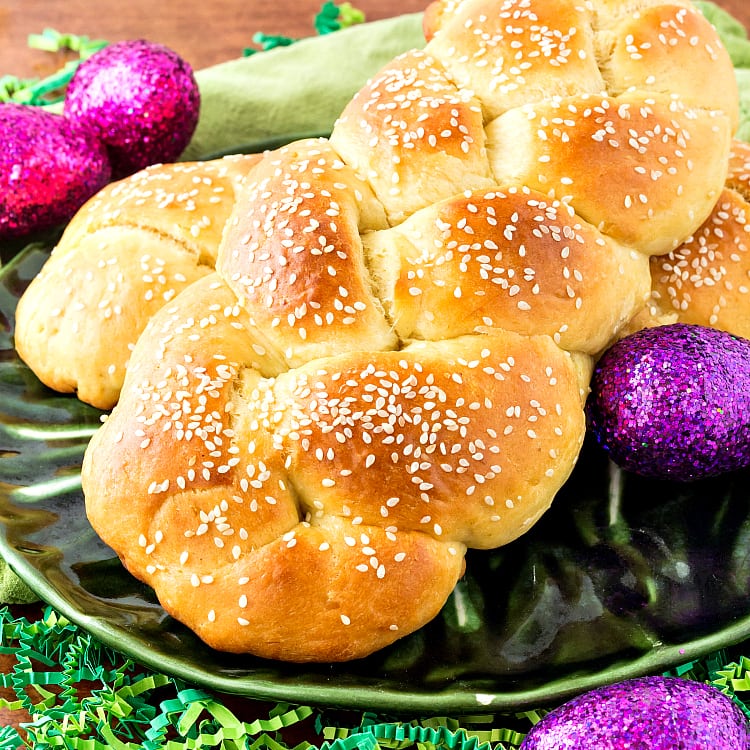
Armenian Easter bread is similar to Greek tsoureki and Turkish coregi (a rose by any other name, as far as I can tell). The recipe I followed as a guide for my choereg called for both mahleb and anise.
I’m not a super fan of anise, so I never have it in the house. I did have ground fennel though, because I like to add that to Italian dishes when my Italian herb blend doesn’t contain fennel. At any rate, it’s what I had, so I went with it.
Yes, I realize that fennel and anise have a similar flavor. I’m sorry, anise. Maybe it’s all in my head.
The combination of the mahleb and fennel is lovely. The cherry/almond/floral notes of the mahleb and the bright, sweet, licorice notes of the fennel blend beautifully.
The resulting dough and eventual bread looks a bit plain but is aromatic and flavorful. It will leave you a)wondering why it tastes so good, and b)wanting more.
Choereg Baking Notes

To Reduce Rise Time
This bread is very sweet and contains a fair amount of butter. Because of its richness, it takes a long time to rise. As in a 4-hour initial rise. And that was in the cozy microwave with a steaming mug of water for company.
Would you like to save this post?
If you would like to shorten up the rising time, you can add a bit more yeast.
I used 2 teaspoons, but you can use a tablespoon to nudge things along. Also consider cutting back on the sugar just a bit–from the 1/2 + cup called for to maybe 1/3 cup.
As is, the bread was completely worth making, and I’m having some trouble resisting it. Still, if a super long rise doesn’t fit into your life, those couple of changes should reduce the rise time substantially.
What To Expect When Handling the Dough
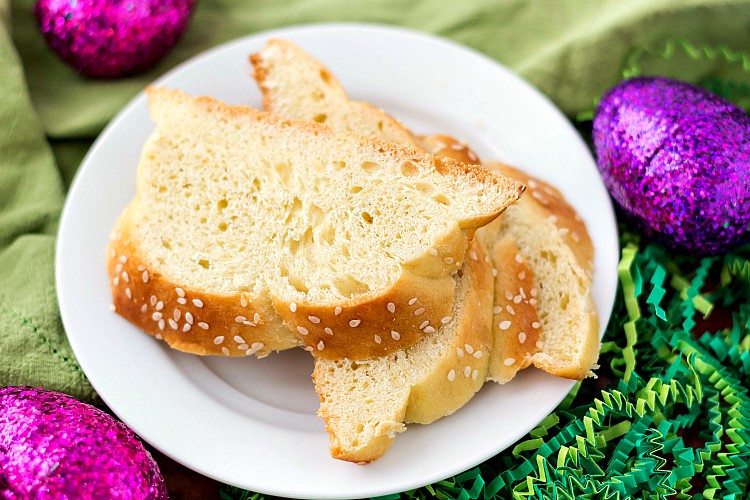
The dough for Armenian Easter bread is very soft and sticky. I wasn’t sure it would behave itself enough for me to roll it out, but the long rise helped reinforce the gluten structure, and it turned out to be very supple.
Just know it will be a soft dough and try to resist the urge to add a bunch of extra flour.
Expect a more cakey and less bready end result. Think brioche rather than baguette.
Reader Review
Reader Ali made this bread, and here is what she said about it:
It was amazing! Thank you so much for the recipe!
Ali D.
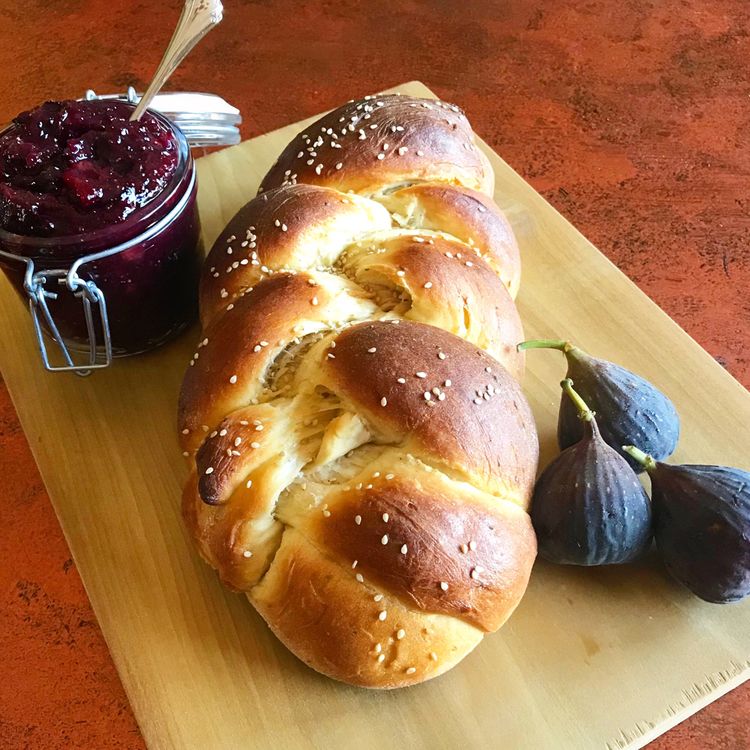
Questions?
If you have any questions about this post or recipe, I am happy to help.
Simply leave a comment here and I will get back to you soon. I also invite you to ask question in my Facebook group, Fearless Kitchen Fun.
If your question is more pressing, please feel free to email me. I should be back in touch ASAP, as long as I’m not asleep.
A Note About Measurements
My recipes are almost all written by weight, including liquids, unless otherwise specified.
For accuracy and consistency of results, I encourage you to buy–and use–a kitchen scale.
I promise that baking and cleanup will be so much quicker and easier.
This is the scale that I recommend for home use. I have owned and used one for years.
Don't let its small price and small size fool you. The Escali Primo is an accurate and easy-to-use food scale that I have used for years. It's easy to store, easy to use, has a tare function, and easily switches between grams and ounces/pounds for accurate measurements.
Please Take a Moment to Rate and Review. Thanks!
It will help me and other readers so much if you take a moment to rate and leave a review for this recipe.
You can use the stars to rate 1-5 (5 is best), and leave a review in the comments. It helps me make adjustments if any are needed, and comments help others decide whether the recipe is worth making.
Other ways to share include pinning, and/or sharing on your favorite social media platform.
Thank you so much for taking the time!

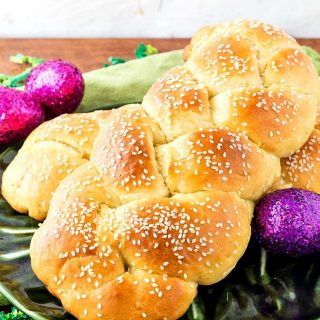
Armenian Easter Bread
Would you like to save this post?
Ingredients
Proofing
- ¼ cup tepid water
- ½ teaspoon sugar
- 2 teaspoons dried yeast (up to 1 Tablespoon. See notes)
For the Dough
- The yeast mixture
- 19.5 oz by weight–about 4 1/2 cups all purpose flour (King Arthur preferred)
- 6 oz 1 1/2 sticks unsalted butter
- 4 oz 1/2 cup whole milk
- 3 large eggs lightly beaten
- scant 2/3 cup granulated sugar (use 1/3-1/2 cup for a less sweet bread)
- 1 Tablespoon freshly ground mahleb (I blitzed mine in the blender. You can also use a spice grinder or mortar and pestle)
- 2 teaspoons ground fennel (or anise)
- 2 teaspoons kosher salt
To Finish and Bake
- 1 egg white
- 1 teaspoon water
- 1 Tablespoon more or less sesame seeds
Instructions
To Proof
- Combine the water, sugar and yeast and stir to combine.
- Let sit for 10-15 minutes until nice and bubbly.
For the Dough
- Warm the butter and milk together until the butter is melted. Let cool to warm.
- Pour the proofed yeast in the bowl of your stand mixer followed by the flour, the milk mixture, the eggs, sugar, spices and salt.
- Fit your mixer with the paddle attachment and bring the dough together on low speed. Increase speed to medium and knead for about 10 minutes. The dough will be soft and will clear the sides of the bowl to only about halfway down. That’s okay.
- When the dough is ready, it will be shiny, smooth, soft, and stretchy.
- Spray the top with pan spray, cover with a lint-free towel, and let rise in a cozy place until doubled. This could take anywhere from 2 to 4 hours, depending on whether you use more or less sugar and/or more or less yeast. See Notes.
- Once the dough has doubled, scrape it out onto a clean, smooth work surface, and gently press out the gases.
- Weigh your dough and divide by 9. If you don’t have a scale, I implore you to get one. If you don’t want to be so exact, divide the dough into thirds and then divide each third into three pieces.
- Press each of three pieces of dough into a rectangle and then roll up into a tight sausage. Roll out each into a rope about 12" long. Pinch the three ropes together at one end and braid fairly tightly. Pinch the dough together when you reach the other end. Tuck each end under the braid for a nice, polished presentation.
- Form two more braids in the same way.
- Place on a parchment-lined baking tray about 2-3 inches apart. Cover with plastic wrap and let rise i a cozy place until puffy, about 45 minutes.
- While the dough is rising, set a rack in the center of your oven. If you have one, place a baking stone on the rack. Otherwise, don’t worry about it.
- Heat the oven to 350F.
To Finish and Bake
- Whisk together the egg white and water.
- Gently brush a thin layer evenly onto each braid. Sprinkle sesame seeds on each braid.
- Bake for 20-30 minutes until lightly golden brown. The internal temperature of the bread should be 200F.
- Remove to a rack to cool completely. Rewarm to serve or serve at room temperature. Butter and jam would not be unwelcome.
- Enjoy!
Did You Make Any Changes?
Notes
Nutrition
And there you have it. Sweet, aromatic braided Easter bread.
Thanks for spending some time with me today. Take care, and have a lovely day.

Hi, y’all! I hope you’ve enjoyed this post and hopefully also learned a thing or two.
If you like my style, I invite you to sign up for my occasional newsletter, The Inbox Pastry Chef.
Expect updates on new and tasty recipes as well as a bit of behind-the-scenes action. I hope to see you there!



Join in Today!
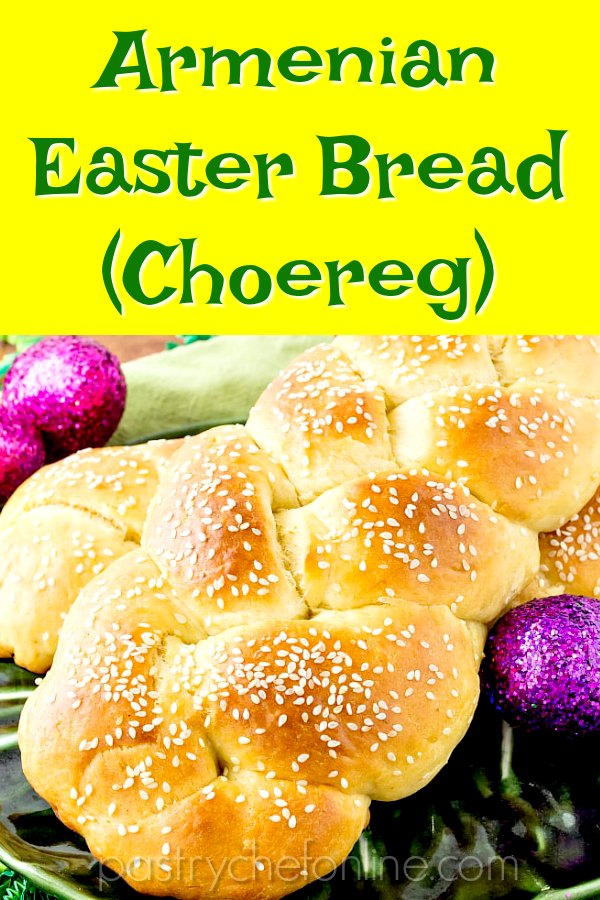


My mother and I made chorags often. Hers had evaporated milk, 3/4-1 cup sugar (hers had some sweetness) I don’t know if mahleb was difficult to obtain, but she used cardamon
Ooh, I love the choice of cardamom! It is definitely a sweet, almost cake-like bread. So tasty. Thanks for sharing how your mom made it, Dick!
My mother is 100% Armenian and me to
Your recipe is the same only we use one can evaporated milk which somehow makes it more tasty but other wise the same I use 4 to 5 eggs as my mother did so we do like my mother
It is my favorites I can eat one every day with Armenian string cheese, I omit the seeds because I can’t have them but put them in there for company and for friends your recipe is perfict also my daughter makes perfect choreg she lightened it up less fat and you never know it very lie and delicious she has her site
The Righteous Kitchen try it you will love it
Thank you making yours today my cousins is the best I have tried all her dishes are 100% beautiful tasty as my daughter ❤
There is somrthing so More-ish about Choereg. Such a wonderful delicate flavor. Thank you for sharing your and your daughter’s variations with me!
I spent an entire weekend creating my grandmother’s Easter bread recipe. No anise. After several batches that were “almost there”, I remembered her evaporated milk cans. Once I used that, it was nailed. Thank you for sharing what your family did. My grandmother had NO written recipes, or if they were they are in Armenian.
My Nana would put sprinkles, M&M’s and gumdrops are the bread. She made this bread at Christmas and Easter. And this bread enjoyed with eggnog is a joyful experience for the mouth!
Oh I’ll have to try with evaporated milk. I bet that brings a bit of caramelized sweetness to the dough! I love you were able to recreate her recipe. That is very special. ❤️
Hi Jenny
I loved the Choereg recipe, thank you. Just a quick note that the instructions do not include mention of incorporating the sugar (missing).
Yikes! Good call, Francine–I will fix that asap. I’m glad you enjoyed the bread. Have a wonderful Easter and stay safe.
So glad you enjoyed the Easter bread! And yes, you’re right — it’s definitely cake-y, like a Finnish pulla or a brioche. Maybe that’s why I like it so much too …
I really love it, Alanna, and my friend’s congregation truly enjoyed it as part of their Communion Celebration on Sunday. 🙂 I’m so glad I found your blog and recipe. I’ll certainly be making this again!
This looks amazing! Who knew adding new flavors would be so fabulous? Sharing on Desserts Required’s FB page manana. <3
That mahleb is so delicious–you need to try it in the next challah you make! And thank you for sharing, my friend. <3